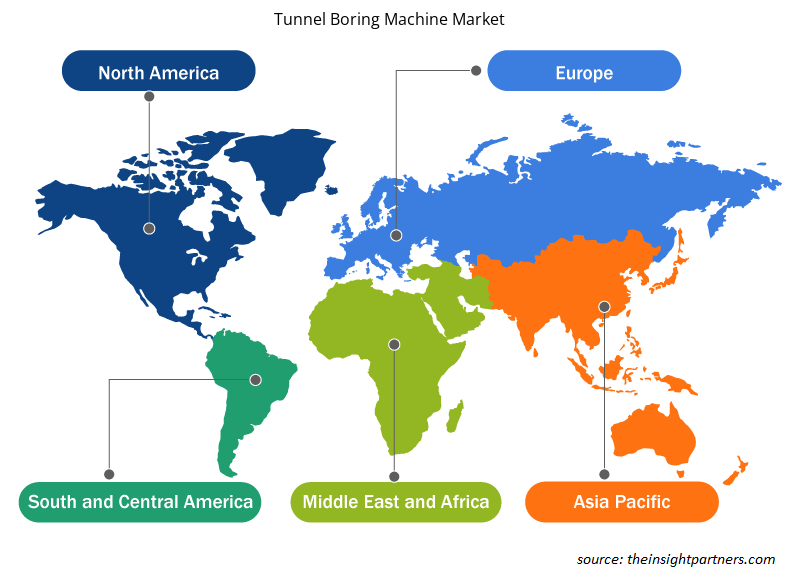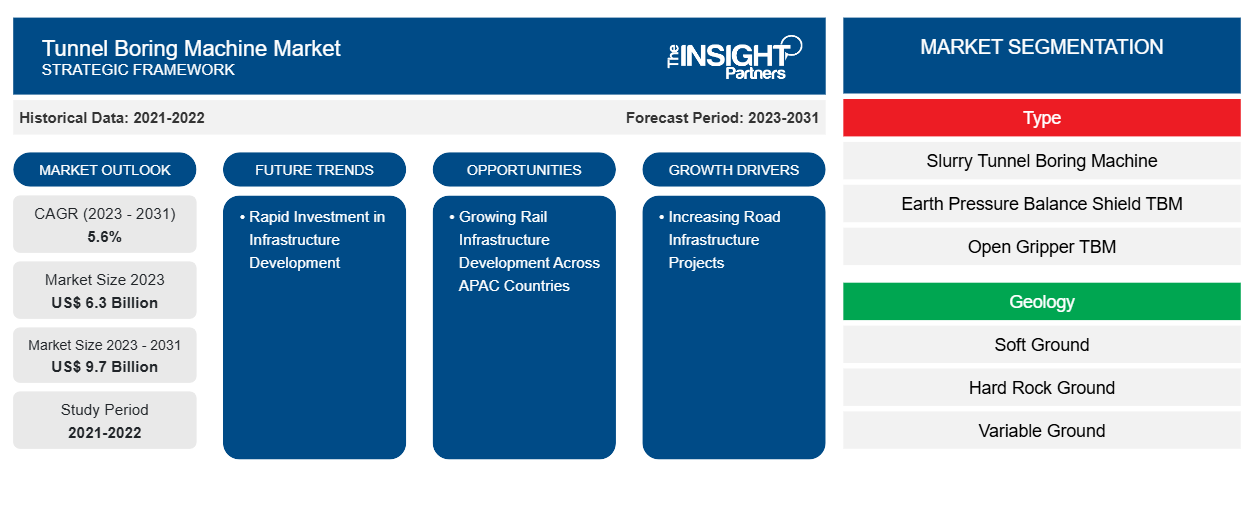隧道掘进机市场规模预计将从 2023 年的 63 亿美元增至 2031 年的 97 亿美元。预计隧道掘进机市场在 2023-2031 年期间的增长率为 5.6%。道路基础设施项目的增加、对微型隧道的关注度增加以及通过自动化和岩石切割技术实现的技术进步是推动隧道掘进机市场发展的关键因素。
隧道掘进机市场分析
由于全球发展中和发达经济体的建设项目数量不断增加,以及对基础设施建设的投资不断增加,预计隧道掘进机市场将在分析的时间范围内经历相当大的增长。此外,全球金属和采矿业以及石油和天然气行业的增长预计将增加对用于油井勘探的隧道掘进机的需求。此外,隧道掘进机越来越多地部署在施工现场,以在山区挖掘隧道,或用于地下施工。
隧道掘进机市场概况
隧道掘进机应用于石油和天然气、基础设施开发以及金属和采矿等几个主要行业。该机器的成功应用取决于选择适合地面条件的设备和切削工具。道路基础设施的增长是推动市场发展的重要因素之一。政府对铁路项目的投资增加预计将推动全球隧道掘进机市场的发展。例如,2021 年 1 月,丹麦和德国之间的费马恩海峡隧道在丹麦开工建设。该项目将于 2029 年完工。该项目将允许开发全球最长的公路和铁路沉管隧道。2019 年 6 月,中国铁路工程设备集团有限公司推出了其隧道掘进机,该机出口到意大利,用于连接米兰和维罗纳的铁路项目。该机器直径为 10.03 米,长 155 米;重 1,800 吨。由于人口增长、隧道基础设施升级和隧道安全法规的加强,发展中经济体的工业化和城市化水平不断提高,预计在预测期内将进一步推动全球隧道掘进机市场的增长。
定制此报告以满足您的需求
您可以免费定制任何报告,包括本报告的部分内容、国家级分析、Excel 数据包,以及为初创企业和大学提供优惠和折扣
- 获取此报告的关键市场趋势。这个免费样品将包括数据分析,从市场趋势到估计和预测。
隧道掘进机市场驱动因素和机遇
增加道路基础设施项目
由于人口和城市化水平的提高,全球道路基础设施和建筑行业正在以惊人的速度增长。各国政府在基础设施方面的支出增加以及公路网络的不断延伸推动着全球市场的发展。各个潜在国家在建设和建造新交通基础设施方面的支出以及对现有基础设施的升级推动了对隧道掘进机的需求。基础设施升级活动、智慧城市的发展以及隧道自动化的增长趋势是推动全球市场发展的几个主要因素。几个主要国家的政府都参与了隧道设计,以实现顺畅的道路运输并缩短旅行时间。
- 2023 年 5 月,总统的 2024 财政年度拨款计划将 Gateway 哈德逊河隧道项目添加到 CIG 资助推荐项目列表中,因为该项目预计完成工程阶段的所有必要步骤。它将准备在 2024 财政年度获得全额资助协议。
- 近年来,印度政府宣布了多项政府资助的基础设施项目,包括巴拉特马拉帕里约加纳项目、纳尔马达河谷开发项目、杰纳布河铁路桥、德里地铁工业走廊、孟买跨港连接线、内陆水道开发项目、新孟买国际项目以及佐吉拉和兹莫尔隧道项目,旨在实现印度基础设施的现代化,提高印度公民的生活质量。
亚太地区铁路基础设施建设不断推进
隧道在亚太地区各国的地铁和城市轨道交通中被越来越多地用于铁路运输。隧道系统的正确建造、管理和维护涉及关键参数的监测,例如通风、信号、照明、气体浓度、温度、气流速度和方向以及应急响应。发达经济体和新兴经济体的铁路部门正在经历增长。因此,预计亚太地区对隧道掘进机的需求将会增加。该地区各国政府越来越多地投资于开发铁路基础设施,这些基础设施包括沿线的各种隧道,并配备了智能设备。
例如,在孟买-艾哈迈达巴德高铁项目中,一台带有 13.1 米宽刀头的隧道掘进机被用于挖掘印度第一条水下铁路隧道。此前,印度部署的最大 TBM 宽度为 12.2 米,用于挖掘孟买沿海公路项目的隧道。因此,发达经济体和发展中经济体铁路项目数量的增加以及对新基础设施建设的投资不断增加,是预计为全球隧道掘进机市场的主要参与者提供充足增长机会的一些关键因素。
隧道掘进机市场报告细分分析
有助于得出隧道掘进机市场分析的关键部分是类型、地质和最终用户。
- 根据类型,隧道掘进机市场分为泥浆式 TBM、土压平衡盾构式 TBM、开放式抓手式 TBM、盾构式 TBM、多模式 TBM 等。泥浆式 TBM 细分市场在 2023 年占据了最大的市场份额。
- 就地质情况而言,隧道掘进机市场分为软地、硬岩地和可变地。软地部分在 2023 年占据了最大的市场份额。
- 根据最终用户,市场细分为运输、金属和采矿、石油和天然气等。运输部门在 2023 年占据了市场主导地位。
隧道掘进机市场份额按地区分析
隧道掘进机市场报告的地理范围主要分为五个区域:北美、欧洲、亚太、中东和非洲、南美和中美。
2023 年,亚太地区占据了隧道掘进机市场的主导地位。亚太地区的市场分为澳大利亚、中国、印度、日本、韩国和亚太地区其他地区。道路、铁路和其他基础设施建设活动的增长预计将使亚太地区的隧道掘进机市场受益。在亚太地区,由于交通运输和公路及铁路基础设施的不断发展,市场参与者对其产品的需求正在增加。中国和日本是亚太地区隧道掘进机市场的领先经济体。在印度,德里地铁公司正在为德里市提供大众快速交通系统 (MRTS) 网络。MRTS 网络是地面、高架和地下的混合体。对于地下网络基础设施,隧道是由泥水式盾构机建造的。在项目的下一阶段,火车站将使用近 14 台隧道掘进机建造一条直径为 5.8 米的隧道。
隧道掘进机市场区域洞察
Insight Partners 的分析师已详尽解释了预测期内影响隧道掘进机市场的区域趋势和因素。本节还讨论了北美、欧洲、亚太地区、中东和非洲以及南美和中美洲的隧道掘进机市场细分和地理位置。

- 获取隧道掘进机市场的区域特定数据
隧道掘进机市场报告范围
| 报告属性 | 细节 |
|---|---|
| 2023 年的市场规模 | 63亿美元 |
| 2031 年市场规模 | 97亿美元 |
| 全球复合年增长率(2023 - 2031) | 5.6% |
| 史料 | 2021-2022 |
| 预测期 | 2023-2031 |
| 涵盖的领域 | 按类型
|
| 覆盖地区和国家 | 北美
|
| 市场领导者和主要公司简介 |
|
隧道掘进机市场参与者密度:了解其对业务动态的影响
隧道掘进机市场正在快速增长,这得益于终端用户需求的不断增长,而这些需求又源于消费者偏好的不断变化、技术进步以及对产品优势的认识不断提高等因素。随着需求的增加,企业正在扩大其产品范围,进行创新以满足消费者的需求,并利用新兴趋势,从而进一步推动市场增长。
市场参与者密度是指在特定市场或行业内运营的企业或公司的分布情况。它表明在给定市场空间中,相对于其规模或总市场价值,有多少竞争对手(市场参与者)存在。
在隧道掘进机市场运营的主要公司有:
- 中国铁建重工有限公司
- 川崎重工业公司
- CREG TBM 德国有限公司
- 泰拉泰克有限公司
- 海瑞克股份公司
- 日立造船株式会社
免责声明:上面列出的公司没有按照任何特定顺序排列。

- 了解隧道掘进机市场主要参与者概况
隧道掘进机市场新闻和最新发展
隧道掘进机市场通过收集一手和二手研究后的定性和定量数据进行评估,其中包括重要的公司出版物、协会数据和数据库。隧道掘进机市场的一些发展情况如下:
- 2023年11月,硅谷交通局为其BART硅谷二期项目从海瑞克购买了一台隧道掘进机。这一战略为海瑞克增加了客户群,并加强了公司在该市场的地位。
- 2020 年 8 月,海瑞克股份公司有史以来在欧洲使用的最大的隧道掘进机于 6 月完工。这台超大型掘进机(土压平衡盾构机,直径 15.87 米)由海瑞克制造。
隧道掘进机市场报告覆盖范围和交付成果
“隧道掘进机市场规模和预测(2021-2031 年)”报告对以下领域进行了详细的市场分析:
- 隧道掘进机市场规模及全球、区域和国家层面所有主要细分市场的预测
- 隧道掘进机市场趋势以及市场动态,如驱动因素、限制因素和关键机遇
- 详细的 PEST/波特五力分析和 SWOT 分析
- 隧道掘进机市场分析涵盖主要市场趋势、全球和区域框架、主要参与者、法规和最新市场发展
- 行业格局和竞争分析,涵盖市场集中度、热点图分析、知名参与者以及隧道掘进机市场的最新发展
- 详细的公司简介
- 历史分析(2 年)、基准年、预测(7 年)及复合年增长率
- PEST和SWOT分析
- 市场规模、价值/数量 - 全球、区域、国家
- 行业和竞争格局
- Excel 数据集
近期报告
相关报告
客户评价
购买理由
- 明智的决策
- 了解市场动态
- 竞争分析
- 客户洞察
- 市场预测
- 风险规避
- 战略规划
- 投资论证
- 识别新兴市场
- 优化营销策略
- 提升运营效率
- 顺应监管趋势





















 获取免费样品 - 隧道掘进机市场
获取免费样品 - 隧道掘进机市场